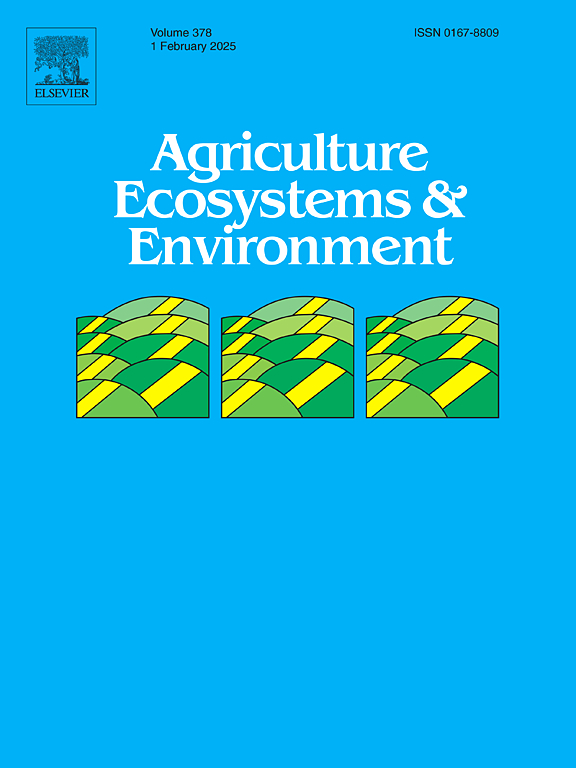Landscape heterogeneity and a competing herbivore reduce olive fruit infestation by the pest Prays oleae
IF 6
1区 农林科学
Q1 AGRICULTURE, MULTIDISCIPLINARY
引用次数: 0
Abstract
Monocultural agricultural systems can favour arthropod pests through direct effects, such as promoting pest dispersion, and indirect effects, such as limiting natural pest control. Therefore, promoting the presence of non-crop habitats in agricultural landscapes has the potential to reduce pest damage. However, likely in part due to the trophic complexity surrounding arthropod pests, these effects vary strongly among different pests and crops, and they are rarely consistent on a year-to-year basis. Here, we formulated Generalized Additive Mixed Models with data of 11 years from 25 olive orchards from southern Spain to evaluate the effects of landscape composition at different spatial scales on fruit infestation by the moth Prays oleae, a key Mediterranean olive pest. Then, we evaluated whether these effects were modulated by natural enemies or heterospecific herbivores. Fruit infestation by P. oleae was affected by landscape composition at small spatial scales (100 m radius), but not at medium or large scales (500 m and 1000 m radii). Fruit infestation was negatively affected by the proportion of semi-natural habitats, while it was positively affected by the proportion of olive groves in the landscape. We did not find evidence that these effects were modulated by natural enemies. However, fruit infestation by P. oleae was negatively affected by the presence of Euphyllura olivina, which is considered a secondary olive pest. Overall, this study shows that the negative response of P. oleae to habitat heterogeneity is consistent across years, but these effects were found only at smaller spatial scales. Therefore, we recommend implementing patches of semi-natural vegetation within olive groves as it can help reduce crop damage caused by P. oleae. Specifically, our models showed that maintaining 25 % of non-crop vegetation within 100 m radius buffer zones would reduce by half the proportion of fruits infested by P. oleae. Interestingly, this study also suggests that the secondary pest E. olivina can prevent fruit infestation by P. oleae, which in turn could increase crop yield.
景观异质性和一种相互竞争的食草动物减少了害虫 Prays oleae 对橄榄果的侵扰
单一耕作的农业系统会通过直接影响(如促进害虫扩散)和间接影响(如限制害虫的自然控制)有利于节肢动物害虫。因此,在农业景观中增加非作物栖息地有可能减少害虫危害。然而,可能部分是由于节肢动物害虫的营养复杂性,这些效应在不同害虫和作物之间存在很大差异,而且很少在年与年之间保持一致。在此,我们利用西班牙南部 25 个橄榄园 11 年的数据建立了广义加性混合模型,以评估不同空间尺度的景观组成对地中海橄榄主要害虫油橄榄夜蛾果实侵染的影响。然后,我们评估了这些影响是否受到天敌或异种食草动物的调节。在小空间尺度(半径 100 米)上,油橄榄夜蛾对果实的侵扰受景观组成的影响,但在中或大尺度(半径 500 米和 1000 米)上则不受影响。果实侵染受到半自然栖息地比例的负面影响,而受到景观中橄榄园比例的正面影响。我们没有发现这些影响受天敌调节的证据。然而,橄榄果被认为是次生害虫,其果实被橄榄蝇侵染却受到了橄榄幼虫(Euphyllura olivina)的负面影响。总之,这项研究表明,油橄榄对生境异质性的负面反应在不同年份是一致的,但这些影响仅在较小的空间尺度上发现。因此,我们建议在橄榄树林中种植成片的半自然植被,因为这有助于减少油橄榄果实对农作物造成的损害。具体来说,我们的模型显示,在 100 米半径的缓冲区内保持 25% 的非作物植被,可将油橄榄果实受 P. oleae 侵染的比例减少一半。有趣的是,这项研究还表明,次生害虫 E. olivina 可以防止果实被 P. oleae 侵害,从而提高作物产量。
本文章由计算机程序翻译,如有差异,请以英文原文为准。
求助全文
约1分钟内获得全文
求助全文
来源期刊

Agriculture, Ecosystems & Environment
环境科学-环境科学
CiteScore
11.70
自引率
9.10%
发文量
392
审稿时长
26 days
期刊介绍:
Agriculture, Ecosystems and Environment publishes scientific articles dealing with the interface between agroecosystems and the natural environment, specifically how agriculture influences the environment and how changes in that environment impact agroecosystems. Preference is given to papers from experimental and observational research at the field, system or landscape level, from studies that enhance our understanding of processes using data-based biophysical modelling, and papers that bridge scientific disciplines and integrate knowledge. All papers should be placed in an international or wide comparative context.
 求助内容:
求助内容: 应助结果提醒方式:
应助结果提醒方式:


